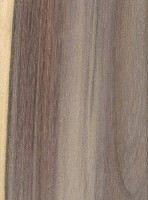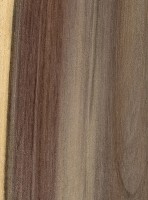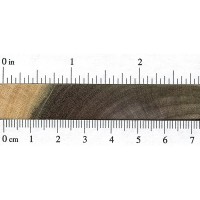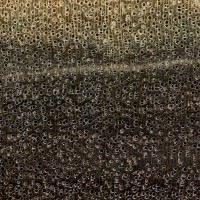 |
Common Name(s): Blue Mahoe Scientific Name: Talipariti elatum (syn. Hibiscus elatus) Distribution: Native to Cuba and Jamaica; widely planted throughout the Caribbean Tree Size: 60-70 ft (18-21 m) tall, 1-2 ft (.3-.6 m) trunk diameter Average Dried Weight: 47 lbs/ft3 (755 kg/m3) Specific Gravity (Basic, 12% MC): .62, .75 Janka Hardness: 1,420 lbf (6,320 N) Modulus of Rupture: No data available Elastic Modulus: No data available Crushing Strength: No data available Shrinkage: Radial: 2.1%, Tangential: 4.9%, Volumetric: 7.1%, T/R Ratio: 2.3 |
Color/Appearance: Heartwood can be highly varied in color, usually grayish or olive brown colored, sometimes with streaks of green, blue, or purple. The narrow sapwood is pale yellow and is clearly demarcated from heartwood. Blue Mahoe is one of very few woods with an overall gray heartwood appearance (in its fresh and unweathered state), and perhaps the only commercially available wood that can exhibit a bluish hue.
Grain/Texture: Grain is usually straight or shallowly interlocked, with a uniform fine to medium texture and a low natural luster.
Endgrain: Diffuse-porous; medium to large pores in no specific arrangement (few to moderately numerous); solitary and radial multiples or clusters of 2-4; growth rings indistinct; rays not visible without lens; parenchyma diffuse-in-aggregates, vasicentric.
Rot Resistance: Reports range from moderately durable to very durable regarding decay resistance. Also reported to be resistant to insect attacks.
Workability: Overall easy to work with both hand and machine tools. Turns, glues, and finishes well.
Odor: Blue Mahoe has a characteristic odor when being worked.
Allergies/Toxicity: Blue Mahoe has been reported to cause sneezing. See the articles Wood Allergies and Toxicity and Wood Dust Safety for more information.
Pricing/Availability: Past over-exploitation has led to very scarce availability of this lumber. Currently, Blue Mahoe is very seldom exported out of its natural range, and wood is typically only available in very small pieces. Expect prices to be high for an imported hardwood.
Sustainability: This wood species is not listed in the CITES Appendices or on the IUCN Red List of Threatened Species.
Common Uses: Cabinetry, furniture, turned objects, carvings, musical instruments, inlay, marquetry, and interior trim.
Comments: Blue Mahoe is the national tree of Jamaica, where it’s prized as a quality furniture wood. Unfortunately, this wood is now in very low supply, and is only infrequently seen (in very small sizes and quantities). It’s perhaps one of the only commercial hardwoods in the world that comes close to possessing a blue heartwood color.
None available.








Does anyone know what type of wood may have been used to carve this unusual 5 1/2 foot high wooden sculpture? It is probably from the 1960s or earlier.
We had a Puerto Rican Cuatro, a traditional Puerto Rican Guitar style instrument, commissioned by Daniel Franco Luthier in Puerto Rico. The back was Made With Mahoe and it came out gorgeous. You can see when it gets delivered to my Dad as a birthday present here https://youtu.be/5_KaWC89Rwo I used it for a chair I made one time as well. – https://www.djemir.com
The color variations on this piece of Blue Mahoe made for a nice look when done.
I would highly recommend this wood for carving. The grain does not chip out and you can get pretty complex shapes from a single piece. It takes a lot of time to polish well since it seems very wear resistant. The scent is very nice. It turns a dark brown when finished with something like Danish oil. I prefer the unusual lavender grey color so leave it unfinished.
Adding another Blue Mahoe carving from a nice block of wood from Puerto Rico. This block had a very consisent lavender color with some greenish areas. The wood is the natural color and has no finish on it. I have not noticed any darkening or significant change in color since it was carved last year. Note that the smaller seaweed carving is from the same block from between the two sponges on the right. Any leftovers went into wooden hearts and other small objects.
More Blue Mahoe Carving (I really like this wood!). This one came from a crotch section and is the darkest Blue Mahone block I have yet worked with. I have seen some pictures on the web with vibrant blues but have not seen one myself. I added a picture of the original block so you can see the darker color on this one.Again there is no finish on the piece. I have used Howard Beeswax finish on smaller pieces and it darkens them quite a bit so if you want to display the unusual color of this wood you may… Read more »
Can you spray this wood in a specific dark brown shade like cedar wood.
I would disagree with the insect resistant statement…got some pieces and one of them was attacked by powderpost beetles
There’s not much specific data on the tree. Can you confirm that the attacks were occurring in the heartwood and not just the sapwood?
Thanks Eric. It is in the hearwood for sure (I could email you pictures if you want).
I have seen other pieces with the same issue
I have a similar issue. Powderpost beetles in my beautiful 9 piece dresser.
I am selling an anique rocking chair made from this wood. It is unique pattened blue from the sixties bought from Camden Town London UK.. 1.80 hight. Verry atractive with a head toes and body. It also has Ivory Vampire teeth.
Delightful wood, wonderful spicy smell, polishes well. Plantation grown in Puerto Rico.
If I was to describe the smell of Blue Mahoe when being worked , I’d say it is like citrus , almost like mandarines sort of like oranges
A great wood to work with…if you can find it. Very pleasant, spicy or perfumy scent when worked. Definitely a blue hue to it which is best brought out in display when grain is oriented horizontal to the ground with overhead lighting. In the attached pic, it’s the top portion of the shield; clearly different in color than the black walnut background.